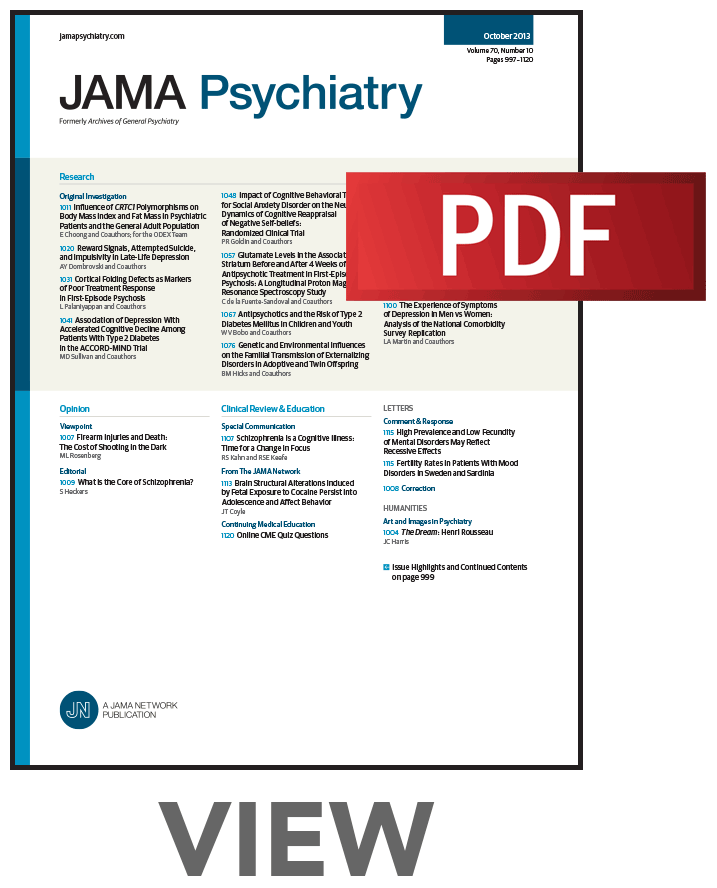Predicting Diagnostic Progression to Schizophrenia or Bipolar Disorder via Machine Learning
IF 22.5
1区 医学
Q1 PSYCHIATRY
引用次数: 0
Abstract
ImportanceThe diagnosis of schizophrenia and bipolar disorder is often delayed several years despite illness typically emerging in late adolescence or early adulthood, which impedes initiation of targeted treatment.ObjectiveTo investigate whether machine learning models trained on routine clinical data from electronic health records (EHRs) can predict diagnostic progression to schizophrenia or bipolar disorder among patients undergoing treatment in psychiatric services for other mental illness.Design, Setting, and ParticipantsThis cohort study was based on data from EHRs from the Psychiatric Services of the Central Denmark Region. All patients aged 15 to 60 years with at least 2 contacts (at least 3 months apart) with the Psychiatric Services of the Central Denmark Region between January 1, 2013, and November 21, 2016, were included. Analysis occurred from December 2022 to November 2024.ExposuresPredictors based on EHR data, including medications, diagnoses, and clinical notes.Main Outcomes and MeasuresDiagnostic transition to schizophrenia or bipolar disorder within 5 years, predicted 1 day before outpatient contacts by means of elastic net regularized logistic regression and extreme gradient boosting (XGBoost) models. The area under the receiver operating characteristic curve (AUROC) was used to determine the best performing model.ResultsThe study included 24 449 patients (median [Q1-Q3] age at time of prediction, 32.2 [24.2-42.5] years; 13 843 female [56.6%]) and 398 922 outpatient contacts. Transition to the first occurrence of either schizophrenia or bipolar disorder was predicted by the XGBoost model, with an AUROC of 0.70 (95% CI, 0.70-0.70) on the training set and 0.64 (95% CI, 0.63-0.65) on the test set, which consisted of 2 held-out hospital sites. At a predicted positive rate of 4%, the XGBoost model had a sensitivity of 9.3%, a specificity of 96.3%, and a positive predictive value (PPV) of 13.0%. Predicting schizophrenia separately yielded better performance (AUROC, 0.80; 95% CI, 0.79-0.81; sensitivity, 19.4%; specificity, 96.3%; PPV, 10.8%) than was the case for bipolar disorder (AUROC, 0.62, 95% CI, 0.61-0.63; sensitivity, 9.9%; specificity, 96.2%; PPV, 8.4%). Clinical notes proved particularly informative for prediction.Conclusions and RelevanceThese findings suggest that it is possible to predict diagnostic transition to schizophrenia and bipolar disorder from routine clinical data extracted from EHRs, with schizophrenia being notably easier to predict than bipolar disorder.通过机器学习预测精神分裂症或双相情感障碍的诊断进展
精神分裂症和双相情感障碍的诊断通常延迟数年,尽管疾病通常出现在青春期晚期或成年早期,这阻碍了靶向治疗的开始。目的探讨在电子健康记录(EHRs)的常规临床数据上训练的机器学习模型是否可以预测因其他精神疾病而在精神科接受治疗的患者的精神分裂症或双相情感障碍的诊断进展。设计、环境和参与者本队列研究基于丹麦中部地区精神病学服务的电子病历数据。所有在2013年1月1日至2016年11月21日期间与丹麦中部地区精神病服务中心至少有2次接触(间隔至少3个月)的15至60岁的患者均被纳入研究。分析时间为2022年12月至2024年11月。基于EHR数据,包括药物、诊断和临床记录的ExposuresPredictors。通过弹性网正则化logistic回归和极端梯度增强(XGBoost)模型预测,在门诊接触前1天,诊断为精神分裂症或双相情感障碍的患者在5年内转变为精神分裂症或双相情感障碍。采用受试者工作特征曲线下面积(AUROC)确定最佳模型。结果共纳入24449例患者(预测时中位[Q1-Q3]年龄为32.2[24.2-42.5]岁;女性13 843人(56.6%)),门诊接触者398 922人。XGBoost模型预测了首次发生精神分裂症或双相情感障碍的过渡,训练集的AUROC为0.70 (95% CI, 0.70-0.70),测试集的AUROC为0.64 (95% CI, 0.63-0.65),测试集由2个医院组成。在4%的预测阳性率下,XGBoost模型的敏感性为9.3%,特异性为96.3%,阳性预测值(PPV)为13.0%。单独预测精神分裂症的效果更好(AUROC, 0.80;95% ci, 0.79-0.81;敏感性,19.4%;特异性,96.3%;PPV, 10.8%)比双相情感障碍(AUROC, 0.62, 95% CI, 0.61-0.63;敏感性,9.9%;特异性,96.2%;PPV, 8.4%)。临床记录特别有助于预测。结论和相关性这些发现表明,从电子病历中提取的常规临床数据可以预测诊断过渡到精神分裂症和双相情感障碍,其中精神分裂症明显比双相情感障碍更容易预测。
本文章由计算机程序翻译,如有差异,请以英文原文为准。
求助全文
约1分钟内获得全文
求助全文
来源期刊

JAMA Psychiatry
PSYCHIATRY-
CiteScore
30.60
自引率
1.90%
发文量
233
期刊介绍:
JAMA Psychiatry is a global, peer-reviewed journal catering to clinicians, scholars, and research scientists in psychiatry, mental health, behavioral science, and related fields. The Archives of Neurology & Psychiatry originated in 1919, splitting into two journals in 1959: Archives of Neurology and Archives of General Psychiatry. In 2013, these evolved into JAMA Neurology and JAMA Psychiatry, respectively. JAMA Psychiatry is affiliated with the JAMA Network, a group of peer-reviewed medical and specialty publications.
 求助内容:
求助内容: 应助结果提醒方式:
应助结果提醒方式:


